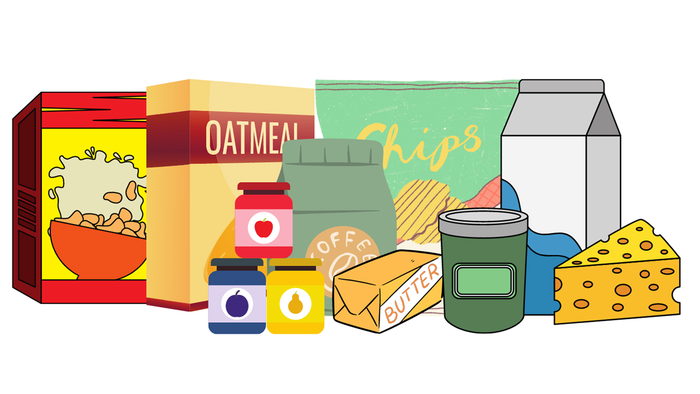April 24, 2008

Part one of a two-part story on carbohydrates and health
 While weight-loss theories abound, some are more prevalent and long-lived than others. The glycemic-index theory is one that has attracted the attention of researchers, dieters and diet-book authors for more than 25 years. The GI theory contends that eating foods that cause a dramatic rise in blood levels of sugar (glucose) and insulin (the hormone that regulates blood-sugar levels) causes weight gain. Eat a low-GI diet, the theory goes, and dieters will lose weight. But this seemingly straightforward concept is far more complex than it may appear. And while some experts contend that the GI of foods is a key factor in weight gain and loss, there is no universal agreement on the effectiveness of eating a low-GI diet. Here's what you need to know about the GI theory of weight loss.
While weight-loss theories abound, some are more prevalent and long-lived than others. The glycemic-index theory is one that has attracted the attention of researchers, dieters and diet-book authors for more than 25 years. The GI theory contends that eating foods that cause a dramatic rise in blood levels of sugar (glucose) and insulin (the hormone that regulates blood-sugar levels) causes weight gain. Eat a low-GI diet, the theory goes, and dieters will lose weight. But this seemingly straightforward concept is far more complex than it may appear. And while some experts contend that the GI of foods is a key factor in weight gain and loss, there is no universal agreement on the effectiveness of eating a low-GI diet. Here's what you need to know about the GI theory of weight loss.
The basics
To understand low-GI diets, it's important to know the terminology. The GI is a numerical value assigned to the blood glucose-raising potential (more specifically, the incremental area under the blood-glucose curve) of a standard amount of a food assessed over two hours. The GI of a particular food represents the relative rate of glucose entry into the bloodstream over a two-hour period after eating 50 grams (about 2 ounces) of the food, compared with eating 50 grams of a reference carbohydrate, typically glucose or white bread.1
The greater the rise in blood sugar, the higher the GI of the food. So GI measures the quality of a carbohydrate—that is, how much a food affects blood sugar over two hours. A related concept, glycemic load, combines the GI of a food with the quantity of that food. GL takes serving size into account. Essentially, the GL multiplies the GI by the amount of carbohydrate in a typical portion. For example, watermelon has a high GI, but that conclusion is based on eating 50 grams of carbohydrate in a watermelon. That's a tremendous amount of watermelon; an actual typical serving provides only about 6 grams of carbohydrate. Therefore, even though the GI of watermelon is high, the GL (the GI multiplied by the amount of available carbohydrates in a serving) is considered low. Many experts say the GL is a more realistic reflection of the impact of carbohydrate-containing foods on blood sugar.2
The GI concept was first developed at the University of Toronto as a tool for the dietary management of type 1 diabetes.3 It only later became a much-used tool for weight loss. The GL was defined in 1997 at Harvard Medical School to account for serving size, as well as the fact that people do not generally eat single foods, but meals or snacks made up of at least two food components with different carbohydrate contents.4
The theory
High-GL foods trigger a large rise in blood sugar, followed by a proportionate rise in insulin. Some researchers have suggested that the unusually large rise in insulin caused by foods high in rapidly digested carbohydrates (like table sugar or white bread) results in weight gain for three reasons: 1) it increases enzymes that play a role in laying down fat; 2) it reduces the body's ability to burn fat for energy and 3) it increases appetite. The use of GI/GL dietary programs has been endorsed by many official health agencies around the world, most notably Australia and the World Health Organization, but they have not been recognized by any governmental or professional entity in the United States.5,6
The research
While animal experiments7,8 and population studies9,10 have shown promise for the effectiveness of low GI/GL diets for weight control, well-controlled human studies have yielded inconsistent results.11,12,13,14,15,16,17 In addition, most human studies have been small (involving fewer than 60 subjects) and short-term (lasting from five weeks to one year). There is no information on the long-term effectiveness of low GI/GL diets for weight loss.
Population studies. Researchers observed a group of 572 healthy adults in central Massachusetts for one year and found that daily dietary GI was independently associated with body-mass index; the higher the GI, the greater the BMI.18 In the first long-term prospective study to examine GI/GL, body weight and body composition, researchers found positive associations between dietary GI and changes in body weight, percentage of body fat and waist size in a group of Danish men and women.10 However, when men and women were analyzed separately, they found the link held up for women, especially inactive women, but not men. No significant associations between GL and weight were observed in either sex.
In a European study of almost 3,000 men and women with type 1 diabetes, researchers found that consumption of low-GI foods was related to lower body weights.9 While low-GI diets are generally lower in carbohydrates, higher intakes of carbohydrates were also linked to lower body-weight measures in this study.
An association between GI and weight has also been found in children. In a retrospective study, a group of 64 children who were instructed to eat a low-GI diet was compared with 43 instructed to eat a reduced-fat diet. Significantly more of those who ate the low-GI diet experienced a decrease in BMI.19
Clinical studies. In a randomized, controlled trial of 129 overweight or obese young adults who were assigned to one of four diets classified as either high- or low-GI, those eating the low-GI diets, especially the women, experienced a greater loss of body fat than those on the higher-GI diets, despite calorie intakes being about the same.17
Low-GI/GL diets may work, in part, by reducing hunger. In a review of 16 studies examining the effects of GI on appetite, all but one demonstrated an increase in satiety, delayed return of hunger or decreased food intake after eating low-GI foods, compared with high-GI foods.18 However, not all studies have found positive results in weight loss. In a 10-week randomized study of 45 healthy, overweight women, half were placed on a low-GI diet and half on a high-GI diet. The researchers found no significant difference between the low-GI group and the high-GI group with regard to appetite or body-weight regulation during the study.14
Whether or not these diets are effective for weight loss may vary from person to person and may depend on whether the person is insulin-resistant (having a diminished ability to respond to insulin). Individuals who are insulin-resistant experience a much higher rise in insulin than others eating the same amount of carbohydrate. One six-month study of 32 healthy, overweight men and women found that a low-GL diet aided weight loss in those who had relatively high insulin levels after eating sugar, whereas those who had relatively low insulin levels did not have greater weight loss on the low-GL diet.15
Animal studies. Rats fed a high-glycemic index diet for three weeks exhibited significant physiological changes compared with rats fed a low-glycemic index diet, including an increase in fatty acid synthase, an enzyme responsible for depositing fat.21 By seven to nine weeks, rats on a high-GI diet develop an increased fat mass, despite having calorie intakes and body weights similar to those on low-GI diets.7,8 In a 32-week study, rats fed a high-GI diet gradually gained weight; these rats were 15 percent heavier and had 40 percent higher fat mass by the end of the study.22
The foods
The GI and GL of foods—even different varieties of the same food—can vary greatly.23 For example, different types of rice can have different GIs.24 The method of processing or cooking a food can greatly change the GI as well; mashing or grinding increases GI. Overcooking pasta greatly increases the GI. Even the ripeness of fruit affects its GI.23 A food with a GL less than 11 is considered a low-GL food; a GL above 19 is generally considered to be high. A food with a GI lower than 55 is considered a low-GI food; more than 70 is considered high (when compared to glucose as the reference food).
The diets
For any diet, the less-processed the food, the lower the GI is likely to be. However, if the diet is high in carbohydrates or serving sizes are large, the GL may be higher, even if the diet consists mainly of high-fiber fruits, vegetables and whole grains.
Generally speaking, a low-GL diet should provide portion-controlled servings of whole fruits, vegetables, whole grains, beans, legumes, nuts and seeds and provide a source of lean protein at each meal or snack. Refined carbohydrates like those in white bread, white flour, baked goods and highly processed packaged foods should be restricted or eliminated. People striving to eat a low-GL diet should aim for meals with a GL of 20 or less; each snack should have a GL of 10 or less. Adding noncarbohydrate foods and beverages such as animal protein, vegetables, fats, oils, nuts and seeds will not affect the GL.
Little information about the GI/GL of specific diet plans is available. However, one analysis found the average daily GL of the popular South Beach Diet to be 34, Sugar Busters! 48 and Dean Ornish's Eat More, Weigh Less 113.25South Beach and Sugar Busters! are low-carbohydrate diets. Ornish's plan is a very-low-fat, high-carbohydrate plan.
The future of GI/GL diets for weight loss
Despite the mixed results from studies testing the effectiveness of low-GI/GL diets for weight loss, the foods included on these diet plans are generally more nutritious, lower in calories and higher in fiber then those in the typical American diet. And despite the results of some negative studies, the preponderance of evidence suggests a positive benefit. Experts believe that the concept of the low-GI/GL diet shows great promise and they call for large, well-controlled, long-term studies to provide definitive answers as to which is the best tool for weight loss (GI or GL) and if the approach is equally effective for men and women. Another question yet to be answered is whether people with already elevated insulin levels might benefit the most from such diets.2,10
Densie Webb, Ph.D., R.D., is a freelance writer and industry consultant based in Austin, Texas.
The first in a two-part series. Click here for part II.
References
1. Bell SJ, Sear B. Low-glycemic-load diets: impact on obesity and chronic diseases. Crit Rev Food Sci Nutr 2003;43(4):357-77.
2. Pereira MA. Weighing in on glycemic index and body weight. Am J Clin Nutr 2006;84:677?9.
3. Jenkins DJ, et al. Glycemic index of foods: a physiological basis for carbohydrate exchange. Am J Clin Nutr 1981;34:362?6.
4. Salmeron J, et al. Dietary fiber, glycemic load, and risk of non-insulin-dependent diabetes mellitus in women. J Am Med Assoc 1997;277:472?7.
5. Ludwig DS. Glycemic load comes of age. J Nutr 2003;133:2695?6.
6. Nutrition Australia. The Glycemic Index Symbol Program. www.nutritionaustralia.org/Food_Facts/Symbols_Foodlabels/glycemic.asp.
7. Pawlak DB, et al. High glycemic index starch promotes hypersecretion of insulin and higher body fat in rats without affecting insulin sensitivity. J Nutr 2001;131:99?104.
8. Pawlak DB, et al. Effects of dietary glycaemic index on adiposity, glucose homeostasis, and plasma lipids in animals. Lancet 2004;364: 778?85.
9. Toeller M, et al. Nutrient intakes as predictors of body weight in European people with type 1 diabetes. Int J Obes Relat Metab Disord 2001; 25:1815?22.
10. Hare-Bruun H, et al. Glycemic index and glycemic load in relation to changes in body weight, body fat distribution, and body composition in adult Danes. Am J Clin Nutr 2006;84:871?9.
11. Bouche C, et al. Five-week, low-glycemic index diet decreases total fat mass and improves plasma lipid profile in moderately overweight nondiabetic men. Diabetes Care 2002;25(5):822?8.
12. Ebbeling CB, et al. A reduced-glycemic load diet in the treatment of adolescent obesity. Arch Pediatr Adolesc Med 2003;157:773?9.
13. Carels RA, et al. Education on the glycemic index of foods fails to improve treatment outcomes in a behavioral weight loss program. Eating Behav 2005;6:145?50.
14. Sloth B, et al. No difference in body weight decrease between a low-glycemic-index and a high-glycemic-index diet but reduced LDL cholesterol after 10-wk ad libitum intake of the low-glycemic-index diet. Am J Clin Nutr 2004;80:337?47.
15. Pittas AG, et al. A low-glycemic load diet facilitates greater weight loss in overweight adults with high insulin secretion but not in overweight adults with low insulin secretion in the CALERIE Trial. Diabetes Care 2005;28(12):2939?41.
16. Raatz SK, et al. Reduced glycemic index and glycemic load diets do not increase the effects of energy restriction on weight loss and insulin sensitivity in obese men and women. J Nutr 2005;135:2387?91.
17. McMillan-Price J, et al. Comparison of 4 diets of varying glycemic load on weight loss and cardiovascular risk reduction in overweight and obese young adults. Arch Intern Med 2006;166:1466?75.
18. Ma Y, et al. Association between dietary carbohydrates and body weight. Am J Epidemiol 2005;161:359?67.
19. Spieth LE, et al. A low-glycemic index diet in the treatment of pediatric obesity. Arch Pediatr Adolesc Med 2000;154(9):947?51.
20. Ludwig DS. Dietary glycemic index and obesity. J Nutr 2000;130:280S?3S.
21. Kabir M, et al. A high glycemic index starch diet affects lipid storage-related enzymes in normal and to a lesser extent in diabetic rats. J Nutr 1998; 128:1878?83.
22. Brand-Miller JC, et al. Glycemic index and obesity. Am J Clin Nutr 2002;76 (suppl):281S?5S.
23. Pi-Sunyer FX. Glycemic index and disease. Am J Clin Nutr 2002;76(suppl):290S?8S.
24. Foster-Powell K, et al. International table of glycemic index and glycemic load values: 2002 Am J Clin Nutr 2002;76:5?56.
25. Shikany JM, et al. Glycemic index and glycemic load of popular weight-loss diets. MedGenMed 2006; 8(1):22.
26. Sugiyama M, et al. Glycemic index of single and admixed meal foods among common Japanese foods with white rice as a reference food. Eur J Clin Nutr 2003;57(6):743?52.
27. Fushimi T, et al. Acetic acid feeding enhances glycogen repletion in liver and skeletal muscle of rats. J Nutr 2001;131(7):1973?7.
28. Johnston CS, et al. Vinegar improves insulin sensitivity to a high-carbohydrate meal in subjects with insulin resistance or type 2 diabetes. DiabetesCare 2004;27(1):281?282.
29. Johnston CS and Buller AJ. Vinegar and peanut products as complementary foods to reduce postprandial glycemia. J Am Diet Assoc 2005;105(12): 1939?42.
30. Brighenti F, et al. Effect of neutralized and native vinegar on blood glucose and acetate responses to a mixed meal in healthy subjects. Eur J Clin Nutr 1995;49(4):242?7.
Natural Foods Merchandiser volume XXVIII/number 1/p. 58, 60
You May Also Like
.png?width=700&auto=webp&quality=80&disable=upscale)


